Natural gas odorant: features of odorants, norms and rules for their entry
Explosions, destruction, and ruined lives are all the tragic consequences of improper operation of gas equipment. Their likelihood is significantly reduced as the leak site is quickly identified and eliminated. But is it so simple detect leak?
You have repeatedly heard that the gas smells by itself and when it leaks, the smell comes from it, right? But this opinion is erroneous - a component known as natural gas odorant is added to the final composition for the smell.
In the presented article, the properties and composition of odorants, the main methods of their introduction to ensure safety both at industrial facilities and in everyday life are examined in detail. Scrupulously reviewed the odorization of natural gas, as well as recent changes in legislation. For easy reading, the text is complemented by videos and illustrations.
The content of the article:
The main properties of odorants
Gas is widely used in everyday life and can provoke severe poisoning, and its high concentration creates an explosive atmosphere. Originally household gas (methane with other impurities, including propane, ethane, butane) is odorless, and any leakage from a closed system could be detected exclusively using special sensors.
They solve this problem by adding to the gas a component with a pronounced smell - odorant. And the direct process of entering the stream is called odorization. Mixing is carried out at a gas distribution station or at centralized points.
Ideally, odorizing substances should possess the following qualities:
- Have a pronounced, specific smell for clear and fast recognition.
- Provide a stable dosage. When mixed with methane and moving through a gas pipe, odorants must exhibit chemical and physical resistance.
- Have a sufficient level of concentration to reduce overall consumption.
- Do not form toxic products during use.
- Additives should not exhibit a corrosive effect in relation to tanks and fittings, which will ensure a long service life of gas equipment and pipelines.
An odorant that fully meets all of the above criteria does not exist. Therefore, the technical specifications TU 51-31323949-94-2002 and the Operating Regulations were developed for Gazprom WFD 39-1.10-069-2002. But these are Gazprom’s internal documents, binding only on organizations belonging to the Gazprom Group.
The document WFD 39-1.10-06-2002 describes the basic requirements for the manufacture, storage, transportation and use of additives.
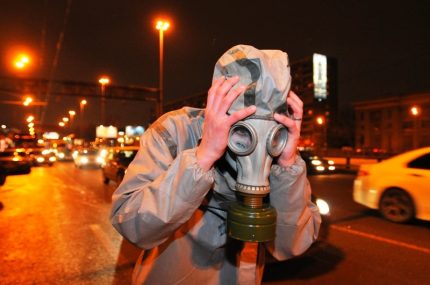
The correct use of odorants in the Rules for the operation of gas pipelines is regulated STO Gazprom 2-3.5-454-2010, where it is indicated that the explosive limit of a flammable liquid is 2.8-18%, and the MPC is 1 mg / m3.
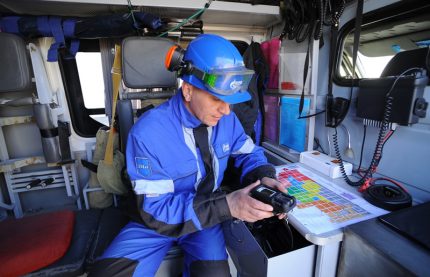
Inhalation of vapors can provoke a desire for vomiting, loss of creation, in large quantities, the substance causes convulsions, paralysis and death. By the degree of exposure to the body, these are harmful substances of the 2nd hazard class. Determine their concentration in the room using a gas analyzer type RSH.
Norms and composition of odorizing substances
Natural gas should be detected by smell in the air when its concentration is not more than 20% of the lower explosive limit, which is 1% of the volume fraction of the organic compound. What to do if your apartment smells of gas, we described in detail in next article.
The amount of odorant in the gas supplied to the consumer depends on the chemical composition of the mixture.
The Regulation on the technical operation of the gas distribution system of the main gas pipelines of the WFD 39-1.10-069-2002 indicates that the input rate ethyl mercaptan equals 16 g per 1,000 m³ of gas.
This odorant was one of the first industrial additives that was used on the territory of the former USSR, but EtSH has several significant drawbacks:
- exhibits easy oxidizability;
- interacts with iron oxides;
- has high toxicity;
- soluble in water.
The formation of diethyl sulfide, to which ethyl mercaptan is prone, reduces odor intensity, especially when transported over long distances. Since 1984, a mixture of natural mercaptans has been used in almost the entire territory of Russia, which includes isopropyl mercaptan, ethyl mercaptan, tert-butyl mercaptan, butyl mercaptan, tetrohydrothiophene, n-propyl mercaptan and n-butyl mercaptan.
The odorant complies with TU 51-31323949-94-2002 “Natural odorant LLC“ Orenburggazprom ””. The norm for this multicomponent supplement does not differ from the recommended amount of ethyl mercaptan.
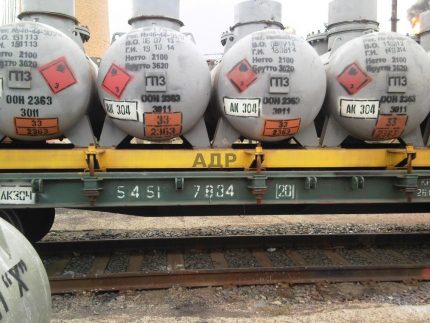
So called mercaptans produced on the basis of hydrogen sulfide, sulfur and sulfides. But modern production is based on the use of sulfur-free compounds, for example, in Germany they produce an environmentally friendly product called Gasodor ™ S-Free ™.
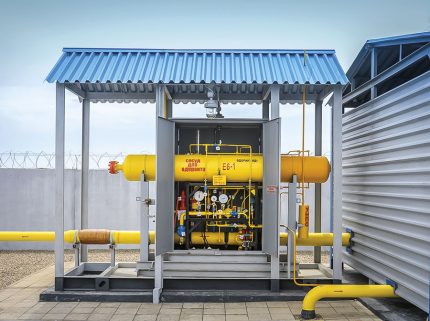
This odorant has a sharp specific smell, maintains stability even during prolonged storage, does not change its qualities when the temperature regime changes.
The additive is highly appreciated for the fact that it does not dissolve in water.When conducting tests that confirmed the suitability of the substance at one of Gazprom’s domestic facilities, an odorant concentration of 10-12 mg / m³ was used.
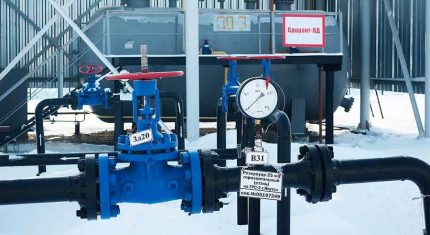
Crotonic aldehyde regarded as a potential odorant. Flammable liquid with a pungent odor, belongs to the second class of danger in terms of exposure to the body.
It has several significant advantages over ethanethiol:
- no sulfur in the composition;
- differs in less toxic effect;
- It has low volatility under normal conditions.
The maximum level of emissions from crotonaldehyde does not exceed the maximum permissible norm and amounts to 0.02007 mg / m3. The possibility of practical use of the substance as an odorant has not yet been studied in detail.
Determination of odorization quality
Complaints about tightly regulated standards for odorization of domestic gas are being received more and more often.
Instead, it is proposed to focus on several factors affecting the quality of odorization of natural gas:
- The state of the gas pipeline and its length. Odor intensity may decrease as a result of chemical reactions between the walls of the gas pipeline and the odorant, in which case an increase in the rate of introduction of the substance into the gas stream will be necessary.
- The need for a change in the norm can also be associated with the specific gravity of mercaptan sulfur in the composition. Knowing its percentage, you can reduce the amount of odorant. With poor fuel quality or accumulation of condensate in the gas pipeline, on the contrary, an increase in the concentration of the substance will be required.
- The conditions of transportation and storage also affect the intensity of the odor.. The use of inappropriate containers, including black steel, sudden changes in temperature and the effects of precipitation, adversely affect the quality of the odorant.
As for the factor of change in component composition, significant costs will be required to carry out the analysis. It is possible to reduce the unjustified consumption of additives with the help of an automated input process; this will also allow solving the environmental and safety issue.
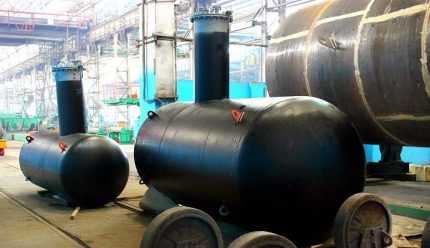
The odorization efficiency also depends on the equipment base, the degree of automation and the method of mixing; we will consider the last parameter in more detail.
Methods for odorizing natural gas
The type of odorant is selected based on several requirements:
- the required level of accuracy;
- sufficient performance;
- material possibilities.
The additive is used both in liquid and in vapor form. The first method involves the drip or the use of a metering pump. To saturate with vapors, an odorant is introduced into part of the gas stream by branching or blowing off the wetted wick.
Method # 1 - drip injection
This input method has a relatively low cost and a simple usage pattern. The principle of operation is based on the calculation of the number of drops per unit time, which allows to obtain the required flow rate.
To transport gas in large volumes, droplets are transformed into a stream of liquid, in such cases, use a gauge scale or a special tank with divisions.
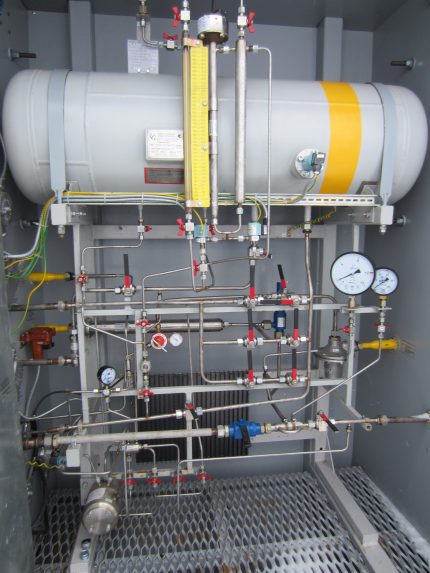
This method requires constant manual adjustment and verification of flow, in particular when changing the number of consumers.
The process is not amenable to automation, therefore its accuracy is low - it is only 10-25%. In modern installations, a dropper is used only as a reserve in case of malfunction of the main equipment.
Method # 2 - use a wick odorizer
Using a wick odorizer is another way that is suitable for small volumes of gas. All operations are carried out manually. The odorant is used for vapor and liquid state, its content is determined by the amount of flow per unit time.
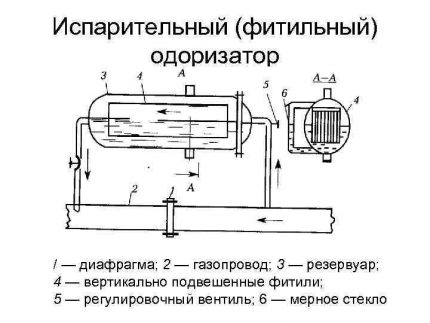
Control the flow by changing the amount of gas that is passed through the wick.
Method # 3 - bubbling odor into gas
Units that use sparging, unlike the previous two, can be automated.
The odorant is supplied using a diaphragm and a dispenser, its amount is calculated in proportion to the gas flow. The substance flows by gravity from the supply tank. Responsible for the process of refueling the ejector.
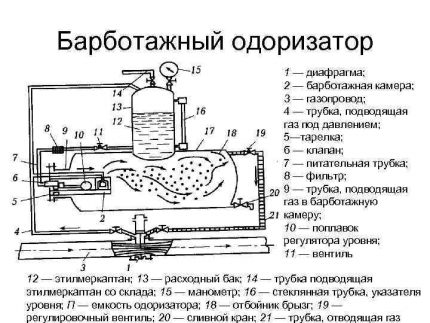
Recent developments to improve the odorization process include the use of metering pumps. They consist of a cleaning filter, an electronic control unit and a control device - a magnet or valve.
Conclusions and useful video on the topic
In detail about the transportation of fuel, how and what odor natural gas will tell an employee of the museum of gas trunk transportation:
An interesting story about the modernization of the odorization installation:
You can watch the installation of the odorizing device in the video clip:
The appearance of a characteristic odor during a gas leak in a room is one of the key conditions safe use gas at home. For the timely detection of unplanned gas releases using odorants.
The odor of the gas must be sufficient for detection and at the same time not exceed the allowable explosion threshold. During a decrease in temperature, the smell weakens, so in winter the amount of odorant administered should be several times lower than in summer.
If you have questions about this topic or want to add useful information on the odorization of natural gas, please leave your comments. The block is located below the text.

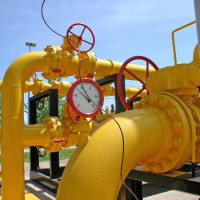 Gas pressure: technical standards + distribution features on the line for gas pressure
Gas pressure: technical standards + distribution features on the line for gas pressure 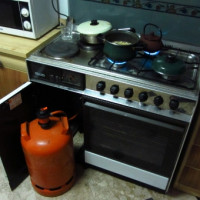 Is it possible to keep a gas cylinder in an apartment: rules and regulations for the use of balloon gas
Is it possible to keep a gas cylinder in an apartment: rules and regulations for the use of balloon gas  Rules for the operation of gas equipment in residential buildings: measures and standards for safe use
Rules for the operation of gas equipment in residential buildings: measures and standards for safe use 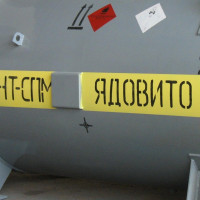 What is the smell of gas called: what gives natural gas a characteristic smell + odorant hazard class
What is the smell of gas called: what gives natural gas a characteristic smell + odorant hazard class 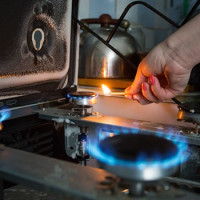 Types of domestic gas: what gas comes to our apartments + features of domestic gas
Types of domestic gas: what gas comes to our apartments + features of domestic gas 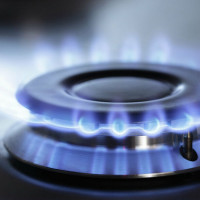 Fire safety of gas equipment: rules and regulations for the operation of gas appliances
Fire safety of gas equipment: rules and regulations for the operation of gas appliances  How much does it cost to connect gas to a private house: the price of organizing gas supply
How much does it cost to connect gas to a private house: the price of organizing gas supply  The best washing machines with dryer: model rating and customer tips
The best washing machines with dryer: model rating and customer tips  What is the color temperature of light and the nuances of choosing the temperature of the lamps to suit your needs
What is the color temperature of light and the nuances of choosing the temperature of the lamps to suit your needs  Replacement of a geyser in an apartment: replacement paperwork + basic norms and requirements
Replacement of a geyser in an apartment: replacement paperwork + basic norms and requirements